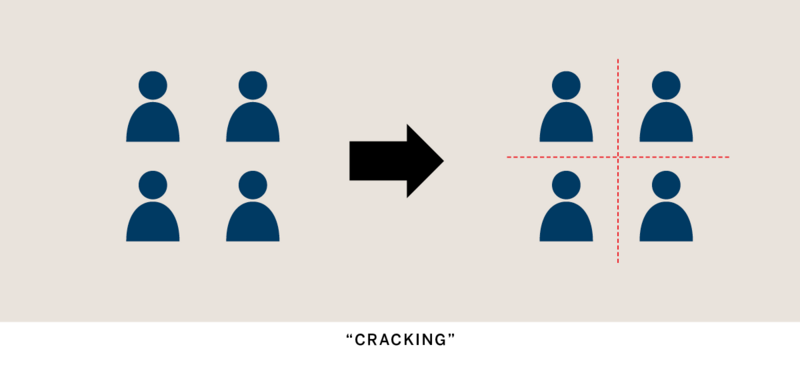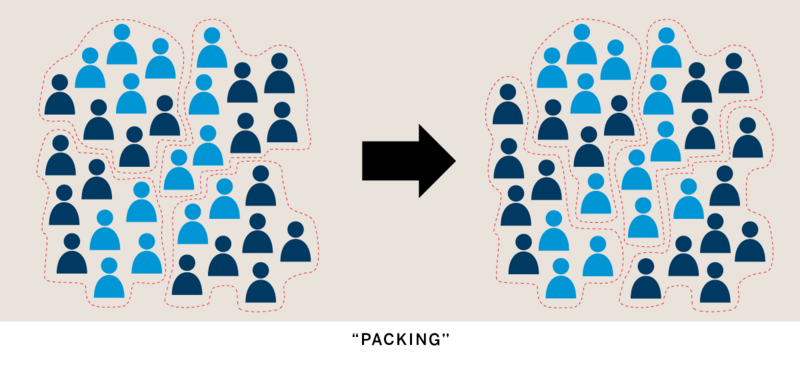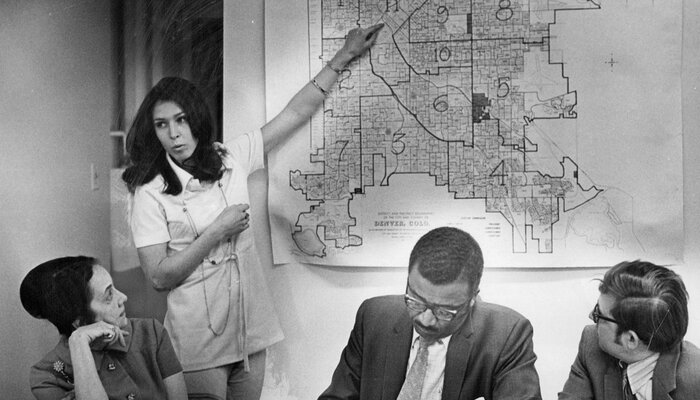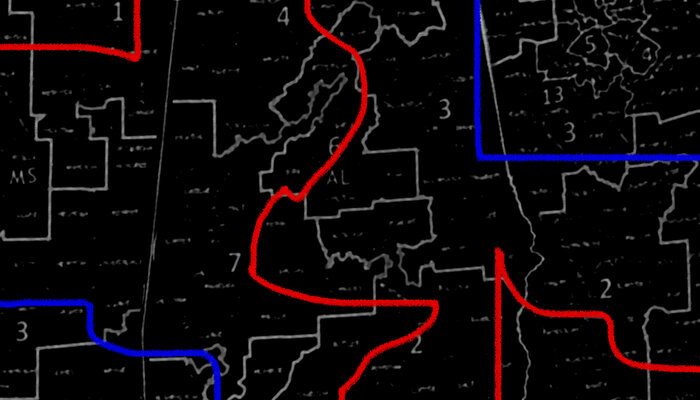After the Census Bureau released detailed population and demographic data from the 2020 census, states and local governments began the once-a-decade process of drawing new voting district boundaries known as redistricting. And gerrymandering — when those boundaries are drawn with the intention of influencing who gets elected — followed.
The latest redistricting cycle was the first since the Supreme Court’s 2019 ruling that gerrymandering for party advantage cannot be challenged in federal court. Here are six things to know about partisan gerrymandering and how it impacts our democracy.
Gerrymandering is deeply undemocratic.
Every 10 years, states redraw their legislative and congressional district lines following the census. Because communities change, redistricting is critical to our democracy: maps must be redrawn to ensure that districts are equally populated, comply with laws such as the Voting Rights Act, and are otherwise representative of a state’s population. Done right, redistricting is a chance to create maps that, in the words of John Adams, are an “exact portrait, a miniature” of the people as a whole.
But sometimes the process is used to draw maps that put a thumb on the scale to manufacture election outcomes that are detached from the preferences of voters. Rather than voters choosing their representatives, gerrymandering empowers politicians to choose their voters. This tends to occur especially when line drawing is left to legislatures and one political party controls the process, as has become increasingly common. When that happens, partisan concerns almost invariably take precedence over all else. That produces maps where electoral results are virtually guaranteed even in years where the party drawing maps has a bad year.
There are multiple ways to gerrymander.
While legislative and congressional district shapes may look wildly different from state to state, most attempts to gerrymander can best be understood through the lens of two basic techniques: cracking and packing.
Cracking splits groups of people with similar characteristics, such as voters of the same party affiliation, across multiple districts. With their voting strength divided, these groups struggle to elect their preferred candidates in any of the districts.

Packing is the opposite of cracking: map drawers cram certain groups of voters into as few districts as possible. In these few districts, the “packed” groups are likely to elect their preferred candidates, but the groups’ voting strength is weakened everywhere else.

Some or all of these techniques may be deployed by map drawers in order to build a partisan advantage into the boundaries of districts. A key note, however: while sometimes gerrymandering results in oddly shaped districts, that isn’t always the case. Cracking and packing can often result in regularly shaped districts that look appealing to the eye but nonetheless skew heavily in favor of one party.
Gerrymandering has a real impact on the balance of power in Congress and many state legislatures.
In 2010, Republicans — in an effort to control the drawing of congressional maps — forged a campaign to win majorities in as many state legislatures as possible. It was wildly successful, giving them control over the drawing of 213 congressional districts. The redrawing of maps that followed produced some of the most extreme gerrymanders in history. In battleground Pennsylvania, for example, the congressional map gave Republicans a virtual lock on 13 of the state’s 18 congressional districts, even in elections where Democrats won the majority of the statewide congressional vote.
Nationally, extreme partisan bias in congressional maps gave Republicans a net 16 to 17 seat advantage for most of last decade. Michigan, North Carolina, and Pennsylvania alone — the three states with the worst gerrymanders in the last redistricting cycle — accounted for 7 to 10 extra Republican seats in the House.
On the state level, gerrymandering has also led to significant partisan bias in maps. For example, in 2018, Democrats in Wisconsin won every statewide office and a majority of the statewide vote, but thanks to gerrymandering, won only 36 of the 99 seats in the state assembly.
Though Republicans were the primary beneficiaries of gerrymandering last decade, Democrats have also used redistricting for partisan ends: in Maryland, for instance, Democrats used control over map-drawing to eliminate one of the state’s Republican congressional districts.
Regardless of which party is responsible for gerrymandering, it is ultimately the public who loses out. Rigged maps make elections less competitive, in turn making even more Americans feel like their votes don’t matter.
Gerrymandering affects all Americans, but its most significant costs are borne by communities of color.
Residential segregation and racially polarized voting patterns, especially in southern states, mean that targeting communities of color can be an effective tool for creating advantages for the party that controls redistricting. This is true regardless of whether it is Democrats or Republicans drawing the maps.
The Supreme Court’s 2019 decision in Rucho v. Common Cause greenlighting partisan gerrymandering has made things worse. The Voting Rights Act and the Constitution prohibit racial discrimination in redistricting. But because there often is correlation between party preference and race, Rucho opens the door for Republican-controlled states to defend racially discriminatory maps on grounds that they were permissibly discriminating against Democrats rather than impermissibly discriminating against Black, Latino, or Asian voters.
Targeting the political power of communities of color is also often a key element of partisan gerrymandering. This is especially the case in the South, where white Democrats are a comparatively small part of the electorate and often live, problematically from the standpoint of a gerrymanderer, very close to white Republicans. Even with slicing and dicing, discriminating against white Democrats only moves the political dial so much. Because of residential segregation, it is much easier for map drawers to pack or crack communities of color to achieve maximum political advantage.
Gerrymandering is getting worse.
Gerrymandering is a political tactic nearly as old as the United States. In designing Virginia’s very first congressional map, Patrick Henry attempted to draw district boundaries that would block his rival, James Madison, from winning a seat. But gerrymandering has also changed dramatically since the founding: today, intricate computer algorithms and sophisticated data about voters allow map drawers to game redistricting on a massive scale with surgical precision. Where gerrymanderers once had to pick from a few maps drawn by hand, they now can create and pick from thousands of computer-generated maps.
Gerrymandering also looks likely to get worse because the legal framework governing redistricting has not kept up with demographic changes. Before, most people of color in the country’s metro areas lived in highly segregated cities. Today, however, a majority of Black, Latino, and Asian Americans live in diverse suburbs. This change has given rise to powerful new multiracial voting coalitions outside cities such as Atlanta, Dallas, and Houston that have won or come close to winning power. Yet the Supreme Court has not granted these multiracial coalition districts the same legal protections as majority-minority districts, making them a key target for dismantling by partisan map drawers.
Federal reform can help counter gerrymandering — so Congress needs to act.
The Freedom to Vote Act, a landmark piece of federal democracy reform legislation that has already passed the House, represents a major step toward curbing political gamesmanship in map drawing. The bill would enhance transparency, strengthen protections for communities of color, and ban partisan gerrymandering in congressional redistricting. It would also improve voters’ ability to challenge gerrymandered maps in court.
With redistricting now beginning in many states, the need for Congress to pass reform legislation is more urgent than ever. Fair representation depends on it.









